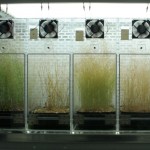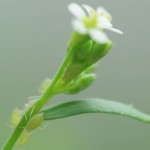No-one can hear you scream…
Plants have the misfortune of being at the bottom of the world’s food chains. In nearly all ecosystems plants are the primary producers, using sunlight to convert carbon dioxide and water into sugar. In turn, the leaves, stems, flowers and sugar-rich sap support all kinds of herbivores, from tiny aphids to some of the largest animals on the planet.
Leaf-chewers and sap-suckers
Herbivores attack plants in a variety of ways: for example, caterpillars mostly chew leaves while elephants can push down entire trees. Aphids (often called greenfly) are tiny bugs with their own specialised way of feeding. Each aphid is equipped with a long proboscis which it uses to stab into the plant’s phloem vessels, which are used to transport sugar from the leaves. Aphids often cluster on actively-growing parts of the plant, such as new shoots or flowers, because these are major sinks for the sugar. Aphids can have a devastating effect on plants and many species are classed as major crop pests. For example, if you’ve ever tried to grow beans or peas, you will undoubtedly be familiar with the black bean aphid, also known as blackfly. Aphids can be particularly damaging because they have an astonishing rate of increase: each female aphid can produce offspring asexually – essentially pumping out clones of herself – and these quickly reach maturity and join the production line.
Chemical warfare
Plants have the disadvantage of not being able to run away when herbivores arrive, but they are by no means defenceless. Plants load themselves up with toxic chemicals and some array themselves in formidable armour to deter herbivores and make themselves unpalatable (see Defence). The diversity of chemicals produced by plants to deter and poison potential herbivores is truly staggering. This diversity arises because herbivores continually find ways to cope with existing defences, putting pressure on plants to invent novel alternatives. The great variety of chemicals that plants produce has not gone unnoticed by humans: most of our drugs are derived from plants, including aspirin, taxol (a breast cancer drug derived from the bark of the Pacific Yew) and digitalin (a heart drug derived from foxglove leaves).
Geographic variation in defences
Even within a single plant species, there is substantial variation in the number and type of chemicals produced and we wanted to investigate whether herbivores are partly responsible for this diversity. We used the model plant, Arabidopsis thaliana, which belongs to the cabbage family and produces different chemical forms of its favourite defence compounds, glucosinolates. We first used pre-existing data to map the pattern of chemical defences across Europe. We found that plants in North-East Europe predominantly produce one chemical form while a different chemical form is dominant in the South-West. Analysing data from a long-term aphid trapping study (The EXAMINE network) revealed that this pattern was correlated with the distribution of two specialist aphids, the cabbage and the mustard aphid, that feed exclusively on members of the cabbage family. The mustard aphid is the dominant aphid in North-East Europe while the cabbage aphid dominates in the South-West. This suggests that the aphids might be responsible for the pattern.

We exposed populations of Arabidopsis to different aphids for several generations. Photos courtesy of Tobias Züst.
An experimental test
To gather further support for this hypothesis we exposed mixed populations of Arabidopsis thaliana to the cabbage and mustard aphid populations typical of North-eastern or South-western Europe. After five plant generations, continuous feeding by the different aphid species led to the selection of different chemical profiles, and these were consistent with the patterns seen in nature. It turns out that the two aphids have different sensitivities to temperature, and that’s probably why they have different distributions. This change in the identity of the dominant aphid across Europe has in turn led to the diversification of plant chemical compounds.
Just one small example of how herbivores can exert tremendous impacts on the ecology and evolution of plants.
Links
Tobias Züst, Christian Heichinger, Ueli Grossniklaus, Richard Harrington, Daniel J. Kliebenstein, Lindsay Turnbull. Natural enemies drive geographic variation in plant defenses. Science 338, 116-119.

